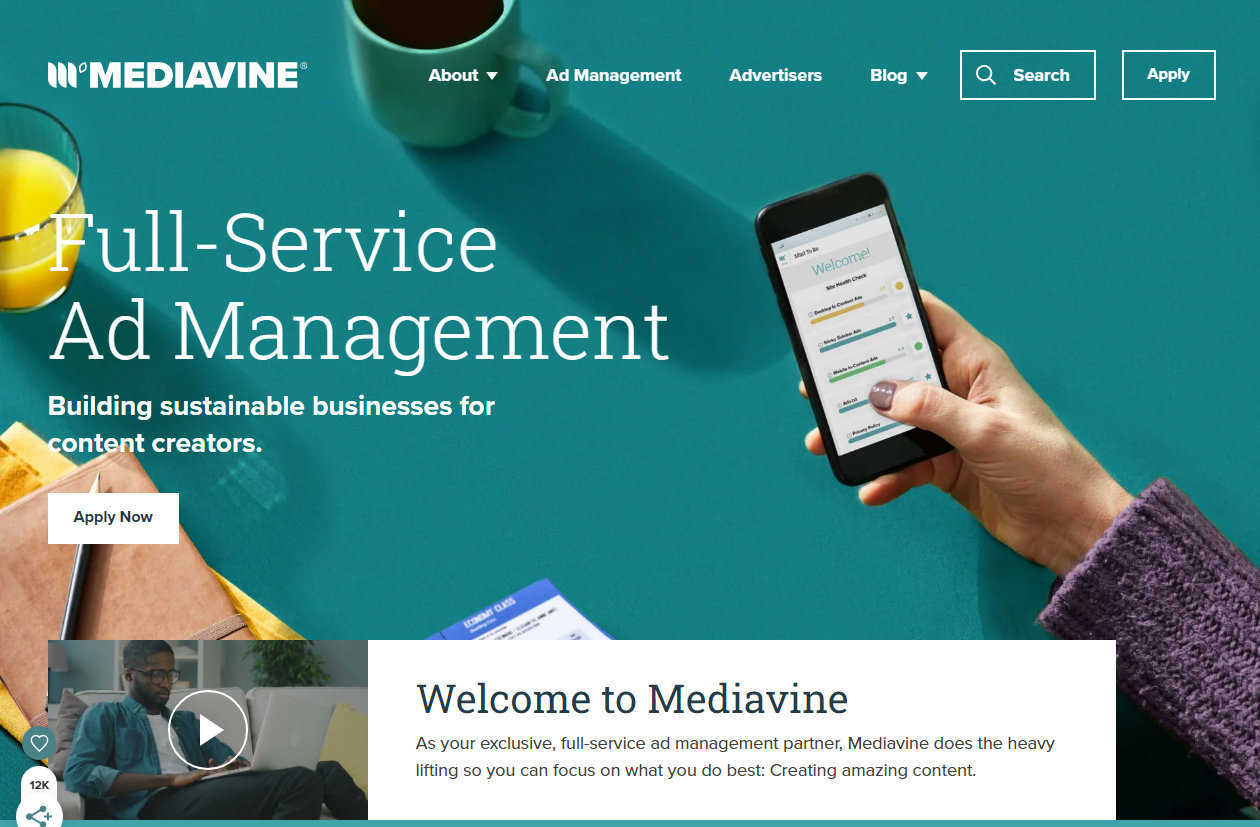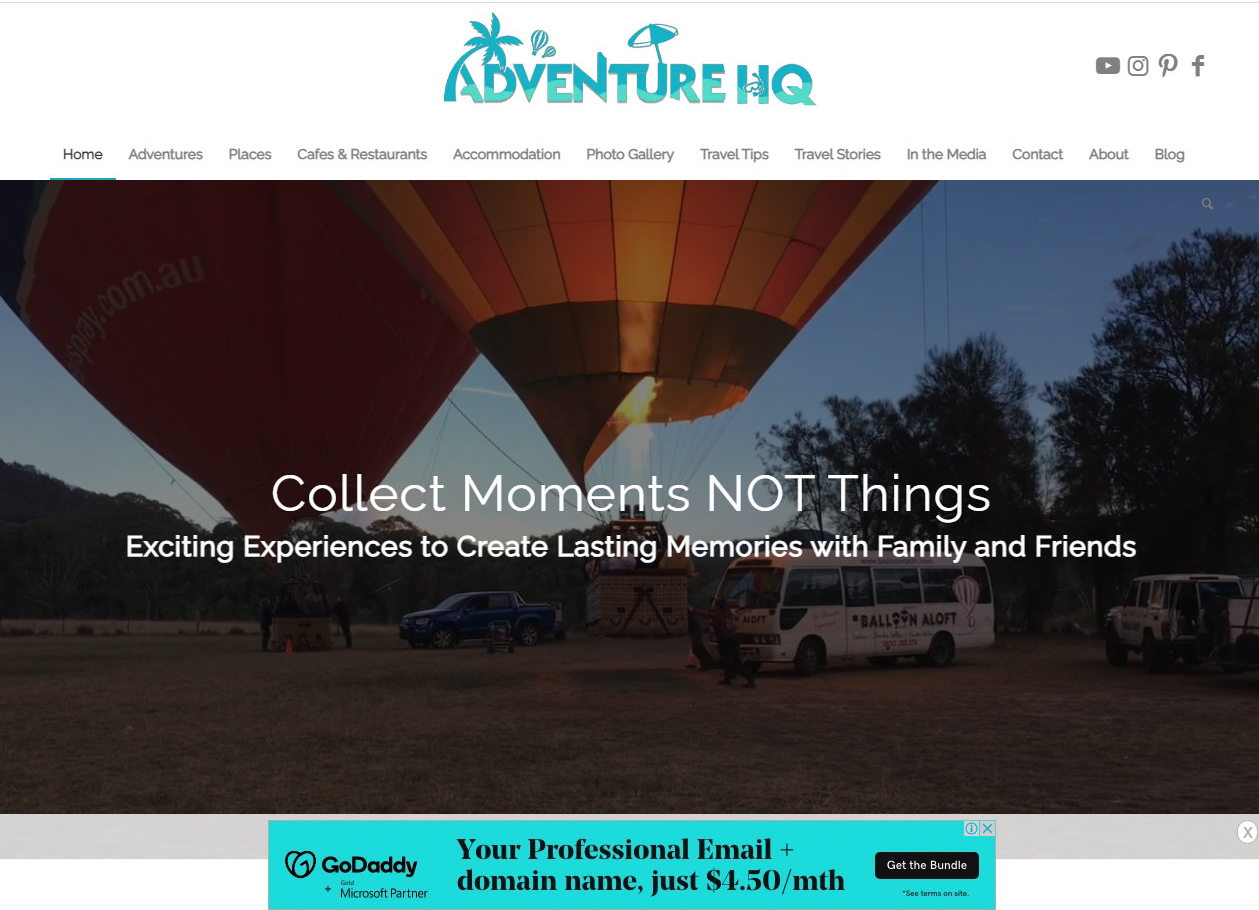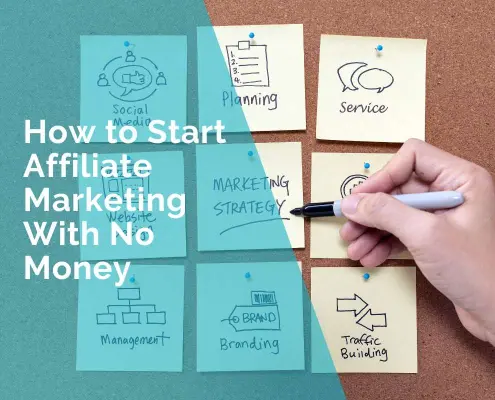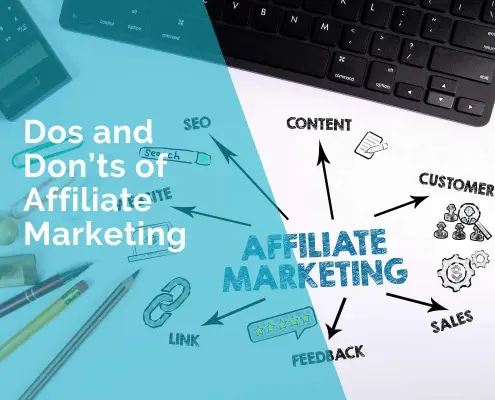Setting Up Your Website for Advertisements
Choosing the Right Website Niche
First things first, think about what really gets you fired up! Your website’s niche is like your online home, so it should be something you’re passionate about. Think about your interests and what you love to talk about.
For example, imagine you’re a plant enthusiast with a green thumb. Your niche could be everything plant-related! From gardening tips to houseplant care, this niche can attract fellow plant lovers and advertisers offering gardening tools or exotic plant varieties.
Creating High-Quality, Engaging Content
Creating high-quality, engaging content is the lifeblood of your website. It’s what draws in visitors, keeps them coming back, and ultimately attracts advertisers. Here’s a deeper dive into how to create content that shines:
Know Your Audience
Before you start creating content, it’s crucial to understand your target audience. Who are they? What are their interests, needs, and pain points? The better you know your audience, the more effectively you can tailor your content to resonate with them.
If your website is about home improvement, your audience might consist of DIY enthusiasts, homeowners, and renters looking to spruce up their spaces. Knowing this helps you craft content that addresses their specific needs and interests.
Unique and Valuable Content
Your content should offer something unique or valuable. It could be information, entertainment, inspiration, or solutions to problems. Aim to provide something that sets your content apart from the competition.
Let’s say you run a tech blog. Rather than just regurgitating the latest tech news, you might offer in-depth product reviews, troubleshooting guides, or practical how-to articles that genuinely help your readers.
Consistency is Key
Regular, consistent updates keep your audience engaged and returning for more. Create an editorial calendar to plan your content ahead of time, and stick to a posting schedule.
If your website is a recipe blog, you could have “Meatless Mondays” or “Dessert Fridays” to create anticipation among your readers for specific content on those days.
Use Visuals
Incorporate images, videos, infographics, and other visual elements to enhance your content. Visuals not only make your content more engaging but also help convey information more effectively.
For example if you are a travel blogger, complement your travel stories with captivating images and even short video clips from your adventures.
Tell Stories
People love stories. We’re naturally drawn to narratives. Share personal experiences, anecdotes, or real-life stories that relate to your content. It humanizes your website and makes it more relatable.
If your website focuses on personal finance, sharing your journey from debt to financial independence can inspire and connect with readers facing similar challenges.
Interactive Elements
Encourage user engagement through comments, polls, quizzes, or surveys. When visitors feel involved and can interact with your content, they’re more likely to stay and return.
Example: If you run a fitness blog, you could include interactive elements like workout challenges, where readers can participate and share their progress in the comments section.
Quality over Quantity
While consistency is important, don’t sacrifice quality for quantity. It’s better to publish one outstanding piece of content than several mediocre ones. Take your time to research, write, and edit thoroughly.
Example: If your website is a history blog, an in-depth article on a lesser-known historical event with meticulous research and engaging storytelling can outperform several hastily written, superficial articles.
Stay Updated
Depending on your niche, information can become outdated quickly. Stay on top of the latest trends, news, and developments in your field. Update or refresh your content as needed to maintain relevance.
Experiment and Adapt
Don’t be afraid to try new formats, topics, or styles of content. Experimentation can lead to discoveries about what resonates most with your audience. Be willing to adapt your content strategy based on what works best.
Optimizing Your Website’s Design and Layout for Ads
It’s important that ads seamlessly blend in with your site’s design, providing a great experience for your visitors.
Ad Placement
Think strategically about where you want to put those ads. Common spots include the header, sidebar, within your content, and at the end of articles. Make sure they don’t disrupt the flow of your website.
Mobile Optimization
With more people browsing on their phones, make sure your website and ads look great on mobile devices. Responsive design is your friend here.
Imagine you’re running a fashion blog. You can strategically place ads in the sidebar and within your fashion articles. Just ensure they don’t overpower your stylish content on mobile phones.
Types of Ads for Your Website
When it comes to monetizing your website with ads, you have a variety of options to choose from. Each type of ad has its own unique characteristics, and the choice depends on your audience, content, and goals. Let’s explore these different ad types in detail:
Display Ads
Display ads are perhaps the most common and recognizable form of online advertising. These are the visual banners, images, or multimedia elements that you see on websites. Display ads can vary in size, design, and placement on your website.
Pros:
- Easy to Implement: Display ads are relatively easy to integrate into your website, especially with the help of ad networks.
- Diverse Formats: They come in various formats, such as banners, rectangles, and skyscrapers, offering flexibility in design.
- Potential for High Visibility: Depending on placement, they can be highly visible to your audience.
Cons:
- Ad Blindness: Users can develop “banner blindness” and may ignore these ads.
- User Experience: Poorly placed or intrusive display ads can negatively impact the user experience.
- Ad Blockers: Some users use ad blockers, which can prevent display ads from appearing.
Example: If you run a technology blog, you might display ads for the latest gadgets or tech accessories in your sidebar or within your articles. Visitors interested in technology are likely to engage with these ads.
Native Ads
Native ads are designed to blend seamlessly with the content of your website, making them appear more like part of your site’s natural flow than traditional ads. They are often labeled as “sponsored” or “recommended” content.
Pros:
- Enhanced User Experience: Because they blend in, native ads are less intrusive and can provide a better user experience.
- Higher Engagement: They tend to have higher engagement rates compared to traditional display ads.
- Relevance: Native ads can be tailored to match your content, making them more relevant to your audience.
Cons:
- Transparency: It’s important to clearly label native ads as “sponsored” to maintain transparency with your audience.
- Complex to Create: Creating effective native ads that seamlessly integrate with your content can be more challenging than traditional display ads.
Example: If you have a travel blog, a native ad might be a well-written article about a travel destination, sponsored by a travel agency, and seamlessly integrated into your list of travel guides.
Video Ads
Video ads are exactly what they sound like—short video clips or commercials that play on your website. They can appear before, during, or after your video content or as standalone advertisements.
Pros:
- High Engagement: Video ads often have higher engagement rates due to their dynamic and visual nature.
- Better Storytelling: They allow for storytelling and product demonstrations that can be highly effective in conveying a message.
- Diverse Formats: Video ads can be in various formats, from short skippable ads to longer brand stories.
Cons:
- Resource-Intensive: Producing video content can be more resource-intensive in terms of time and money.
- User Experience: Poorly implemented video ads can interrupt the user experience, leading to higher bounce rates.
Example: If you manage a cooking blog, video ads might showcase a brand’s kitchen appliances or cooking ingredients, demonstrating their use in a cooking tutorial video.
Text Ads
Text ads are simple, text-based advertisements that appear within your content or in designated ad spaces on your website. They are often associated with pay-per-click (PPC) advertising models.
Pros:
- Non-Intrusive: Text ads are less visually intrusive, preserving the clean and minimalist look of your website.
- Relevance: They can be highly targeted based on keywords, ensuring they align with your content.
- Effective for Niche Audiences: For highly specialized niches, text ads can be very effective.
Cons:
- Limited Creativity: Text ads lack the visual appeal of display or video ads.
- Lower Engagement: They typically have lower click-through rates (CTR) compared to more visually appealing ad types.
Example: If your website is about personal finance, text ads might promote financial planning tools or investment services, offering valuable solutions to your audience.
Affiliate Marketing Ads
Affiliate marketing ads involve promoting products or services from a third party. You earn a commission for each sale or action generated through your referral. These ads can take various forms, including banners, text links, pay-per-call advertising, or even entire product reviews.
Pros:
- Revenue Potential: Affiliate marketing can yield high commissions, especially for products or services with a significant price point.
- Relevance: You can choose affiliate products that align with your content and audience’s interests.
Cons:
- Content Integration: Effectively integrating affiliate ads into your content can be challenging and requires careful consideration.
- Tracking: Managing multiple affiliate relationships and tracking conversions can become complex as your site grows.
Example: If you run a beauty blog, you might have affiliate links within your product reviews, directing readers to e-commerce sites where they can purchase the reviewed beauty products. You earn a commission on each sale.
Sponsored Content
Sponsored content, also known as sponsored posts or advertorials, involves creating content that is paid for by an advertiser and integrated into your website. This content often closely resembles your regular content but is explicitly labeled as sponsored.
Pros:
- Higher Revenue: Sponsored content can command higher fees than traditional ads.
- Integration: When done well, it seamlessly integrates into your website’s style and content.
Cons:
- Transparency: Maintaining transparency by clearly labeling sponsored content is essential for trust.
- Content Control: You may have limited creative control over sponsored content, as it must align with the advertiser’s objectives.
Example: If you manage a travel blog, a sponsored content piece could be an article about a luxurious resort in a travel destination, funded by the resort itself, and clearly marked as sponsored content.
Websites generally earn between
$5-50 from ads per 1,000 views
Joining an Ad Network
Once your website is set up for advertisements and you have quality content ready to roll, it’s time to partner with an ad network. Ad networks act as intermediaries between advertisers and publishers (that’s you!). In this section, we’ll explore the process of joining an ad network, including exploring popular options, applying to become a publisher, meeting ad network requirements, and evaluating your choices.
Exploring Popular Ad Networks
Before diving in, it’s important to research and explore various ad networks. Popular ad networks often have a broad reach and a variety of ad types. Here are a few well-known ones:
- Google AdSense: Google’s AdSense is a widely used ad network that offers a variety of ad formats, including text, display, video, and native ads. It’s known for its user-friendly interface and wide range of advertisers.
- Media.net: This ad network focuses on contextual advertising, serving relevant ads based on your website’s content. It’s a great choice for those who value content relevance.
- Amazon Associates: If your website has an e-commerce focus, Amazon Associates can be an excellent choice. You can promote Amazon products and earn commissions on sales generated through your affiliate links.
- AdThrive: AdThrive recently rebranded under the name of Raptive. The platform iss a popular choice for bloggers and content creators. They offer premium ad placements and focus on optimizing ad revenue.
- Sovrn: Sovrn offers a range of ad types and is known for its transparency in reporting and payments.
- Ezoic: Ezoic specializes in ad optimization, helping publishers increase their ad revenue through machine learning and data-driven insights.
- Mediavine: Like AdThrive, Mediavine is popular among bloggers and content creators. They focus on premium ad placements and offer advanced reporting and optimization tools.

Applying to Become a Publisher
Once you’ve identified an ad network that suits your website and audience, it’s time to apply to become a publisher. Here’s how you can typically apply:
- Visit the Ad Network’s Website: Go to the ad network’s official website and look for a “Publishers” or “Join Us” section.
- Fill Out an Application: You’ll need to provide information about your website, such as its URL, niche, traffic statistics, and content type. Some networks may require additional details.
- Agree to Terms and Conditions: Read through the network’s terms and conditions carefully. This is where you’ll find information on payment terms, ad placement guidelines, and other important rules.
- Submit Your Application: After completing the application, submit it for review. Ad networks may take a few days to a few weeks to assess your website and decide whether to approve your application.
Meeting Ad Network Requirements
Ad networks typically have certain requirements that you must meet to become a publisher. While requirements can vary, here are some common criteria:
- Quality Content: Ad networks prefer websites with high-quality, original, and regularly updated content. Your content should adhere to their content policies.
- Traffic Volume: Some ad networks require a minimum level of website traffic to ensure that advertisers receive sufficient exposure. This threshold can vary widely.
- Compliance: Your website should comply with the ad network’s guidelines, including rules on content, user experience, and ad placement.
- Ad Placement: Ad networks may have specific rules about where ads can be placed on your site. Ensure your website layout aligns with these guidelines.
- Domain Ownership: You typically need to own the domain you’re applying with. Free hosting services may not be accepted.
- Legal Compliance: Ensure your website has a privacy policy, adheres to copyright laws, and respects user data protection regulations.
- User Engagement: Some ad networks assess user engagement metrics like bounce rate, session duration, and pageviews per visit.
Evaluating Ad Network Options
Choosing the right ad network is crucial for your website’s success. Here are factors to consider when evaluating your options:
- Reputation: Research the ad network’s reputation. Look for reviews and feedback from other publishers to gauge their experiences.
- Ad Formats: Consider the types of ad formats offered and whether they align with your website’s layout and user experience.
- Revenue Share: Understand the revenue-sharing model, including how much of the ad revenue you’ll receive versus what goes to the network.
- Payment Terms: Review payment terms, including the minimum payout threshold and payment methods.
- Support: Evaluate the level of customer support provided by the ad network. Responsive support can be vital when issues arise.
- Ad Quality: Assess the quality and relevance of the ads provided by the network. Low-quality or irrelevant ads can harm your user experience.
- Reporting and Analytics: Look for robust reporting and analytics tools that help you track your ad performance and make data-driven decisions.
- Policies and Guidelines: Carefully read through the network’s policies and guidelines to ensure they align with your website’s content and goals.
- Payment Reliability: Investigate whether the ad network has a history of reliable and timely payments to publishers.
Remember that you’re not limited to one ad network. Some publishers choose to work with multiple networks to diversify their revenue streams. However, managing multiple networks can be more complex, so it’s important to strike a balance that works for you.
Placement and Strategy
Monetizing your website with ads isn’t just about displaying them anywhere and everywhere. It requires careful planning and strategy to maximize both user experience and revenue. In this section, we’ll delve into the intricacies of ad placement and strategy, covering key aspects like strategic ad placement, mobile optimization, avoiding ad overload, ad tracking, and A/B testing for optimization.
Placing Ads Strategically on Your Website
- Above the Fold: Consider placing some ads above the fold, which is the portion of the webpage that’s visible without scrolling. These ads are often seen first and tend to receive more clicks.
- Within Content: Integrating ads naturally within your content can be effective. For instance, place an ad in the middle of a blog post or article where it aligns with the topic.
- Sidebar: Sidebars are traditional spots for ads. However, be mindful not to overcrowd your sidebar with ads, as it can clutter your website.
- Header and Footer: Header and footer placements can work well for banner-style ads. These positions are typically visible on every page of your site.
- Exit-Intent Popups: Consider using exit-intent popups, which appear when a user is about to leave your site. These can be effective in capturing additional clicks or conversions.
- Experiment with Different Positions: Don’t be afraid to experiment with ad placements to see what works best for your audience. Monitor performance metrics to identify which positions yield the best results.
Using Responsive Ad Units for Mobile Optimization
With an increasing number of users accessing websites on mobile devices, it’s crucial to optimize your ad units for mobile. Here’s how:
- Responsive Design: Ensure your website uses responsive design, which adapts to different screen sizes. This helps in maintaining the integrity of your ad placements on mobile devices.
- Mobile-Friendly Ad Formats: Many ad networks offer mobile-friendly ad formats. Use these formats to ensure that ads are appropriately sized and displayed on mobile screens.
- Testing on Mobile: Regularly test how your ads appear and perform on mobile devices. This includes checking load times, readability, and responsiveness.
Avoiding Ad Overload
While ads are a key revenue source, too many of them can overwhelm your users and harm your website’s credibility. Here’s how to avoid ad overload:
- Prioritize User Experience: Always prioritize user experience over ad revenue. If ads interfere with your content or make it difficult for users to navigate your site, you risk losing visitors.
- Balanced Ratio: Maintain a balanced ratio of content to ads. A common guideline is the 70/30 rule, where 70% of your website should be dedicated to content, and 30% to ads.
- Ad Density: Avoid stacking too many ads close to each other. Ensure there’s sufficient spacing between ads to prevent visual clutter.
- Intrusive Ads: Avoid intrusive ad formats, such as pop-ups that cover the entire screen or auto-play video ads with sound. These can frustrate users.
Ad Tracking and Performance Analysis
Tracking and analyzing the performance of your ads is essential for optimizing your revenue. Here’s how to do it effectively:
- Use Analytics Tools: Most ad networks provide analytics tools that help you track key metrics like click-through rate (CTR), earnings per click (EPC), and conversion rates.
- Regularly Review Data: Set aside time regularly to review your ad performance data. Look for patterns and insights that can guide your optimization efforts.
- Segmentation: Segment your data to gain a deeper understanding of how different ad placements, ad types, or audience segments are performing.
- Conversion Tracking: Implement conversion tracking to measure the actual impact of ads on your goals, whether it’s sales, sign-ups, or other actions.
- Experiment: Don’t be afraid to experiment with different ad types, placements, and strategies. Test changes to see how they affect your ad revenue and user experience.
A/B Testing for Ad Optimization
A/B testing, or split testing, involves comparing two versions of a webpage or ad to see which one performs better. Here’s how to use A/B testing for ad optimization:
- Identify a Variable: Choose a specific element to test, such as ad placement, ad format, ad color, or ad copy.
- Create Variations: Create two versions of the element: the control (original) and the variation (the change you want to test).
- Randomly Assign Users: Randomly assign users to see either the control or the variation. Ensure the testing process is unbiased.
- Measure Results: Track the performance of both versions, focusing on relevant metrics, like CTR or conversion rate.
- Analyze and Implement: Analyze the results to determine which version performed better. Implement the winning version to improve your ad revenue.
- Iterate: Continue testing and iterating to refine your ad strategies continually.

Ad Revenue and Payment Models
Understanding how ad revenue works and the various payment models is essential for effectively monetizing your website. In this section, we’ll delve into the intricacies of ad revenue models, tracking and maximizing your ad revenue, and the process of receiving payments from ad networks.
Understanding Ad Revenue Models
To make money with ads on your website, you need to comprehend the different ad revenue models that advertisers use. Here are the three primary models:
- Cost Per Click (CPC)
- How It Works: With CPC advertising, you earn revenue each time a user clicks on an ad displayed on your website. Advertisers pay you based on the number of clicks their ads receive.
- Example: If you have a CPC ad on your website, and a visitor clicks on it, you’ll earn a small commission for that click. The amount can vary depending on the ad and the niche.
- Pros: You earn revenue when users take an action (click), which can be relatively easy compared to other models.
- Cons: CPC rates can vary widely, and you need a substantial volume of clicks to generate significant income.
- Cost Per Mille (CPM)
- How It Works: CPM advertising pays you a certain amount for every 1,000 ad impressions (views) regardless of whether users click on the ads or not.
- Example: If an advertiser agrees to pay you $5 CPM, you’ll earn $5 for every 1,000 times their ad is viewed on your site.
- Pros: CPM provides a steady income stream based on the number of views, even if users don’t click on ads.
- Cons: CPM rates can be lower than CPC rates, and you need substantial traffic to make significant income.
- Cost Per Acquisition (CPA)
- How It Works: CPA advertising is based on a user taking a specific action after clicking on an ad, such as making a purchase or signing up for a service. You earn a commission for each successful action.
- Example: If you have a CPA ad for a fitness product, and a user clicks on it and then buys the product, you’ll earn a commission on that sale.
- Pros: CPA can be highly profitable because you earn commissions for successful conversions.
- Cons: Users need to complete a specific action for you to earn revenue, which can be challenging to achieve in some cases.
Tracking and Maximizing Ad Revenue
To maximize your ad revenue, you should adopt strategies to track and optimize your ad performance continuously:
- Ad Performance Tracking: Use analytics tools provided by ad networks to monitor key metrics like CTR, CPM, or CPA. This data can help you identify which ads and placements are performing best.
- A/B Testing: Conduct A/B tests to compare different ad placements, formats, or ad copies. Experiment with variations to find the most effective combinations.
- Ad Placement Optimization: Regularly review and adjust your ad placements based on performance data. Focus on positions that yield the best results.
- Content Quality: High-quality, engaging content can lead to more ad impressions and clicks. Focus on producing valuable content that attracts and retains visitors.
- Audience Targeting: Understand your audience and tailor your content and ads to their interests and demographics. Targeted ads are more likely to perform well.
- Ad Blockers: Be aware of ad blockers and consider using strategies like anti-ad-blocking scripts or less intrusive ad formats to ensure your ads are seen by users.
Receiving Payments from Ad Networks
Receiving payments from ad networks is typically straightforward, but it’s essential to understand the process:
- Payment Threshold: Most ad networks have a payment threshold, which is the minimum amount you must earn before they release payment. Ensure you meet this threshold before expecting a payout.
- Payment Frequency: Ad networks have different payment schedules, such as monthly, quarterly, or when you reach the payment threshold. Familiarize yourself with your network’s payment frequency.
- Payment Methods: Ad networks offer various payment methods, including bank transfers, checks, PayPal, and direct deposits. Choose the method that is most convenient and cost-effective for you.
- Tax Considerations: Depending on your location and the ad network’s policies, you may need to provide tax information or fill out tax forms. Ensure you comply with tax regulations in your area.
- Payment Statements: Ad networks typically provide payment statements or invoices detailing your earnings and deductions. Keep these records for your financial records and tax purposes.
- Payment Timing: Payments can take time to process and reach your account, so be patient. If you encounter payment delays or issues, contact the ad network’s support team.
- Multiple Networks: If you work with multiple ad networks, consider using a payment aggregator or service that consolidates payments from various sources for convenience.
Remember that ad revenue may fluctuate due to various factors, including seasonality, changes in ad demand, and shifts in user behavior. Consistency in content creation and audience engagement is key to maintaining a stable income from ads on your website.
Challenges and Tips for Success
Making money with ads comes with its fair share of challenges, but with the right strategies and mindset, you can overcome these hurdles and achieve success. In this section, we’ll explore common challenges and offer tips to help you navigate them effectively.
Dealing with Ad Fraud
Ad fraud is a prevalent issue in the digital advertising world. It involves fraudulent activities that aim to inflate ad metrics or steal advertising budgets. Here’s how to deal with ad fraud:
Pro Tips:
- Monitor Traffic Sources: Regularly monitor the sources of your website traffic. Look for unusual spikes or patterns that could indicate bot traffic.
- Use Ad Verification Tools: Invest in ad verification and fraud prevention tools that can help identify and block fraudulent activity.
- Report Suspicious Activity: If you suspect ad fraud, report it to your ad network or advertising platform. They often have mechanisms in place to address such issues.
- Stay Informed: Keep up with the latest developments in ad fraud prevention. The digital advertising industry is continually evolving to combat fraudulent practices.
Managing Fluctuations in Ad Revenue
Ad revenue can be volatile, with fluctuations influenced by factors such as seasonality, economic conditions, and shifts in advertising budgets. Here’s how to manage these fluctuations:
Pro Tips:
- Diversify Revenue Streams: Consider diversifying your income sources. Explore affiliate marketing, sponsored content, or selling digital products to reduce your reliance on ad revenue alone.
- Create a Financial Buffer: During high-revenue periods, set aside a portion of your earnings as a financial buffer to help cover expenses during leaner times.
- Budget Wisely: Develop a budget that allows you to manage your finances efficiently, even when ad revenue fluctuates.
- Optimize Your Content: Continuously work on improving your content and user engagement to attract more traffic, which can help mitigate revenue fluctuations.
Building and Retaining Website Traffic
Building and retaining a consistent flow of website traffic is essential for ad revenue. Here are some strategies to achieve this:
Pro Tips:
- SEO Optimization: Invest in search engine optimization (SEO) to improve your website’s visibility in search results. Target relevant keywords and create high-quality content.
- Content Marketing: Develop a content marketing strategy that includes creating valuable, shareable content that appeals to your target audience.
- Social Media Promotion: Use social media platforms to promote your content and engage with your audience. Social media can be a powerful driver of website traffic.
- Email Marketing: Build an email list and use email marketing to nurture relationships with your audience. Send regular updates, newsletters, and exclusive content to keep readers engaged.
- Community Building: Foster a sense of community around your website. Encourage user comments, discussions, and interactions to keep visitors coming back.
- Mobile Optimization: Ensure your website is mobile-friendly, as an increasing number of users access websites via mobile devices.
Staying Updated with Industry Trends
The digital advertising landscape is constantly evolving. Staying informed about industry trends is crucial for success:
Tips:
- Continuous Learning: Dedicate time to learning about digital advertising trends, new ad formats, and emerging technologies. Attend webinars, conferences, or online courses.
- Network with Peers: Connect with other website owners and digital marketers to exchange insights and stay updated on industry developments.
- Follow Industry News: Subscribe to industry-specific blogs, newsletters, and publications to receive regular updates on trends, changes in ad policies, and best practices.
- Experiment and Adapt: Be open to trying new ad formats and strategies. Experimentation can lead to breakthroughs in optimizing your ad revenue.
Making money with ads can be a great way to earn income, but it’s not without its challenges. The key is to strike a balance between ads and providing a great experience for your visitors. Stay curious and keep learning about the world of online advertising, and be prepared for things like fake clicks or fluctuations in your earnings. By putting your audience first, exploring various ways to generate income, and constantly improving your content, you’ll be well on your way to making the most of ads on your site while keeping your readers happy and engaged. Remember, it’s a journey, so enjoy the ride!
Find out about other ways to earn money from your website.
Frequently Asked Questions about Making Money with Ads
What is website monetization through ads?
Website monetization through ads is a way to make money from your website by displaying advertisements. Advertisers pay you for allowing their ads to appear on your site. You can earn money when visitors interact with these ads, such as clicking on them, viewing them, or making purchases through them. It’s a common method for bloggers, content creators, and website owners to generate revenue.
How do I get started with ad monetization?
Getting started with ad monetization involves a few steps. First, you need to sign up with an ad network or platform like Google AdSense, Media.net, or others. Once you’re approved, the network provides you with ad code that you can place on your website where you want the ads to appear. These ads will then start displaying to your website visitors, and you’ll earn money based on the ad network’s payment model.
What types of ads can I display on my website?
You have several options for the types of ads you can display on your website. These include:
- Display Ads: These are graphical ads that can appear as banners or boxes on your site.
- Native Ads: These ads blend in with your site’s content and appear more seamless.
- Video Ads: Video content that plays within or alongside your website’s content.
- Text Ads: These are text-based ads, often in the form of links or small snippets of text.
- Affiliate Marketing Ads: Promote products or services, and earn a commission for each sale or action.
- Sponsored Content: Create content that’s sponsored by an advertiser and labeled as such.
How do I choose the right ad network for my website?
Choosing the right ad network depends on several factors. Consider your website’s niche, audience size, and ad format preferences. Some networks specialize in certain niches, while others offer a wide range of ad types. Look into the payout options and terms as well. Research and compare different ad networks to find the best fit for your website’s goals.
What is ad revenue based on?
Ad revenue is primarily based on the ad revenue model you choose. Here are the three primary models:
- Cost Per Click (CPC): You earn money when visitors click on ads.
- Cost Per Mille (CPM): You earn money based on the number of ad impressions (views) per thousand.
- Cost Per Acquisition (CPA): You earn money when visitors click on ads and then take a specific action, such as making a purchase.
Each model has its advantages and may be more suitable for different types of websites and content.
How can I track my ad revenue and performance?
Most ad networks provide analytics tools that allow you to track key performance metrics such as click-through rate (CTR), earnings, impressions, and more. These tools offer insights into how your ads are performing and help you optimize your ad strategy. Additionally, you can use third-party analytics tools to gain deeper insights into user behavior and ad performance.
How can I prevent ad fraud on my website?
Ad fraud is a concern in the digital advertising world. To address it, monitor your website’s traffic sources regularly. Look for unusual spikes or patterns that could indicate bot traffic. Invest in ad verification and fraud prevention tools that can identify and block fraudulent activity. If you suspect ad fraud, report it to your ad network or advertising platform, as they often have mechanisms to address such issues. Stay informed about the latest developments in ad fraud prevention to protect your website and your revenue.
How can I deal with fluctuations in ad revenue?
Fluctuations in ad revenue are common and can be managed. To handle these fluctuations effectively:
- Diversify your income sources by exploring other monetization methods, such as affiliate marketing, sponsored content, or selling digital products.
- Create a budget to manage your finances efficiently during both high-earning and low-earning periods.
- Continuously optimize your content and ad strategies to attract more traffic and increase user engagement, which can help stabilize your income.
Is it possible to monetize a low-traffic website with ads?
Yes, it’s possible to monetize a low-traffic website with ads, but the earnings may be modest. To make the most of it:
- Focus on growing your audience by consistently producing high-quality content.
- Explore alternative monetization methods alongside ads, such as affiliate marketing or selling digital products.
- Be patient and persistent, as building traffic takes time, but it can lead to increased ad revenue as your website grows.
 Ivana Katz from Websites 4 Small Business is an award winning web designer who builds websites that build your business. She provides unbeatable web design services to fit your budget.
Ivana Katz from Websites 4 Small Business is an award winning web designer who builds websites that build your business. She provides unbeatable web design services to fit your budget.
The end result? Professional, custom-made sites that give your business the extra oomph it needs to stand out from the competition and make an impact.
Whether you’re a brand-new business or an established one ready to improve your digital presence, Ivana makes it easy to get your business online very quickly. Her websites are professional, tailored to fit your budget, and give your business a serious boost.
Download your FREE copy of “Ultimate Website Design Secrets Blackbook – 10 Bulletproof Strategies for Designing an Outrageously Successful Website”













